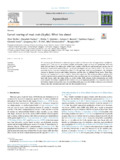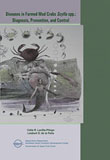Ovarian maturation stages of the mud crab Scylla serrata
| dc.contributor.author | Quinitio, Emilia T. | |
| dc.contributor.author | de Pedro, Jennette | |
| dc.contributor.author | Parado-Estepa, Fe Dolores | |
| dc.date.accessioned | 2014-05-21T08:37:46Z | |
| dc.date.available | 2014-05-21T08:37:46Z | |
| dc.date.issued | 2007 | |
| dc.identifier.citation | Quinitio, E. T., de Pedro, J., & Parado-Estepa, F. D. (2007). Ovarian maturation stages of the mud crab Scylla serrata. Aquaculture Research, 38(14), 1434-1441. | en |
| dc.identifier.issn | 1355-557X | |
| dc.identifier.uri | http://hdl.handle.net/10862/2069 | |
| dc.description.abstract | Ovarian maturation in adult wild-sourced and pond-grown Scylla serrata (Forsskål) was determined based on gross morphology and histological appearance. There were no significant differences noted in the histological features of both wild and pond-reared S. serrata females. Ovarian maturation was classified into five stages: immature, early maturing, late maturing, fully mature and spent. The immature ovaries are thin and translucent to off white and contain oogonia, primary oocytes with large nuclei. The follicle cells were found around the periphery of the lobes and an area among groups of oogonia and oocytes. The follicle cells gradually enclosed the oocytes. The early-maturing ovaries were yellow and small yolk globules started to appear in larger oocytes. In late-maturing ovaries, the colour became light orange and lobules were apparent. Yolk globules occurred in the cytoplasm with larger globular inclusions towards the periphery, while follicle cells were hardly recognizable. Fully mature ovaries were orange to deep orange and had swollen lobules. Large yolk globules were apparent in the entire cytoplasm. Follicle cells were hardly seen. Spent ovaries were similar to the early-maturing and late-maturing stage in partially spawned females. The ovarian development was correlated closely to the gonadosomatic index, oocyte diameter, and ovarian histology. The classification of ovarian maturation provides baseline information for further studies on reproductive biology. Likewise, the information provides a guide for broodstock management in the hatchery. | en |
| dc.description.sponsorship | This study was supported by the European Union through the European Commission — Culture and Management of Scylla spp. Project (ICA4-CT-2001-10022). The authors thank Quirico Ganon of Crustacean Hatchery Unit for obtaining the crabs, Jeobert Fernando and Ronelo Torrigue for broodstock maintenance and the staff of the Microtechnique Unit of SEAFDEC/AQD for processing histological samples. | en |
| dc.language.iso | en | en |
| dc.publisher | Blackwell Publishing | en |
| dc.subject | Decapoda | en |
| dc.subject | Scylla serrata | en |
| dc.title | Ovarian maturation stages of the mud crab Scylla serrata | en |
| dc.type | Article | en |
| dc.identifier.doi | 10.1111/j.1365-2109.2007.01650.x | |
| dc.citation.volume | 38 | |
| dc.citation.issue | 14 | |
| dc.citation.spage | 1434 | |
| dc.citation.epage | 1441 | |
| dc.citation.journalTitle | Aquaculture Research | en |
| seafdecaqd.databank.controlnumber | 2007-17 | |
| dc.subject.asfa | bottom culture | en |
| dc.subject.asfa | breeding stock | en |
| dc.subject.asfa | classification | en |
| dc.subject.asfa | crustacean culture | en |
| dc.subject.asfa | cytoplasm | en |
| dc.subject.asfa | developmental stages | en |
| dc.subject.asfa | embryonic development | en |
| dc.subject.asfa | mud | en |
| dc.subject.asfa | sexual maturity | en |
| dc.identifier.essn | 1365-2109 | |
| dc.subject.scientificName | Scylla serrata | en |
Files in this item
| Files | Size | Format | View |
|---|---|---|---|
|
There are no files associated with this item. |
|||
This item appears in the following Collection(s)
-
Journal Articles [1258]
These papers were contributed by Department staff to various national and international journals.



